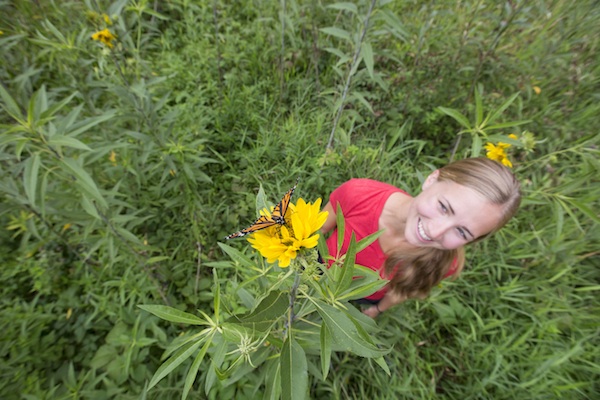
Milkweed, Monarchs and Models
It is an epic journey. The monarch’s annual migration over multiple generations spans from southern Canada to central Mexico. Monarch populations have been declining over the past two decades. Scientists attribute their decline to extreme climate fluctuations in North America, deforestation in Mexico and widespread loss of the milkweed plant.
Monarch butterflies only lay their eggs on the underside of milkweed leaves. When the hungry caterpillars emerge, they eat the leaves on which they were placed. While the caterpillars only eat milkweed, as butterflies they take their nourishment from the nectar of many flowers, in addition to milkweed.
Current research indicates that enhancing monarch habitat in rural landscapes in the upper Midwest could assist in stabilizing and enhancing monarch butterfly populations. But how many milkweed and nectar plants are needed? Where should they be placed on the rural landscape?
Iowa State researchers are using technology to understand how to help this iconic butterfly bounce back.
Epic flight, super computer
Tyler Grant, a postdoctoral researcher at Iowa State, is developing a unique and complex computer program to model monarch butterfly behavior in rural Iowa. Grant’s model can simulate the movements of 100,000 individual butterflies at one time. It’s derived from a smaller scale model created by a research team in Australia, Iowa geospatial information and the expertise of Iowa State University entomologists, ecologists and agronomists.
“Tyler’s model will help us understand how different spatial arrangements of monarch habitat could influence the number of monarchs we can produce in Iowa,” says Steven Bradbury, a professor in the Department of Natural Resource Ecology
and Management. “To run the model we use high performance computing resources at Iowa State and a super computer at the U.S. Department of Interior.”
“Using the model, we can simulate habitat changes in the landscape before we do it in the real world, to see what works to encourage an increase in monarch eggs laid in Iowa,” says Grant. Preliminary results from the model suggest that 50 percent of eggs laid in Story County are laid in roadsides.
“What if we filled up all the roadsides with milkweed, or added milkweed in unused corners of fields? What if 50 percent of the gardens in Iowa had a little patch of milkweeds? We can determine what impact these changes would make,” adds Grant.
Bradbury is excited about the multiple benefits he foresees. “The model could potentially be used as an online decision support tool for farmers or farm advisers. It could provide insights into which locations on his or her land would be the most beneficial for planting monarch habitat. This model could eventually be linked up with decision-support tools being developed for placement options of nutrient reduction technologies,” he says.
Big movements, tiny transmitters
To enhance the model Grant is developing, Kelsey Fisher, a graduate research assistant in entomology working with Bradbury, began tracking the movements of real monarch butterflies this past July.
Fisher and three undergraduate interns, armed with radio signal receivers, placed themselves around the perimeter of a prairie approximately half the size of a football field. Before releasing a monarch butterfly in the center of the prairie, Fisher attached a transmitter—a device that emits radio signals—to the butterfly’s thorax with super glue. The transmitter is the size of a sunflower seed. Together with its three-inch antenna, it weighed about half as much as the monarch.
“We used four people, in case one person missed a reading, to ensure we would get at least three points we could use to triangulate the butterfly’s location. Every 60 seconds we would take a compass bearing in the direction of the loudest beep from the receiver,” says Fisher. “Using those three bearings we calculate an estimated location. For each butterfly we take bearings every 60 seconds for 45 minutes, so we have 45 estimated locations which can be connected to create a path.”
When monarchs leave the prairie area, they are caught in a net. After 45 minutes of triangulating its location, they remove the $180 transmitter, to be used again. So far, Fisher’s team has tracked ten different monarch butterflies.
“This past summer’s research was to troubleshoot our methods and make sure monarchs with transmitters attached could fly like ‘untagged’ butterflies,” says Fisher.
Next summer, Fisher’s team will scale up the research to include more complicated and larger landscapes, such as prairie next to a roadside next to a corn field.
“A lot of the fall and winter is going to be seeing how we can analyze the data we collected with different software, digesting what we’ve learned and seeing how we can make the research better,” says Fisher.
It’s groundbreaking work according to Bradbury. “The model that Tyler is working on is unique. And nobody is doing what Kelsey is doing, either,” he says.
Grant’s and Fisher’s research will help the Iowa Monarch Conservation Consortium and the Iowa Department of Natural Resources create science-based guidelines for establishing and maintaining monarch habitat in Iowa’s rural landscapes in concert with agricultural production. Bradbury anticipates that increasing monarch butterfly habitat in rural Iowa will complement current state conservation programs and reap benefits for other pollinators and soil and water conservation.



